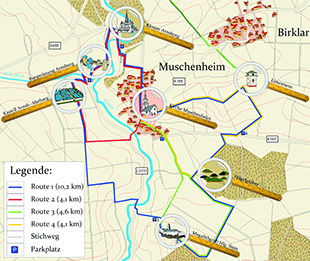Historic cultural circular paths
The four different routes lead to many interesting historical sites where remains of centuries tell of times gone by. At the most important sites are large charts which bring the past back to live.
In the tourist information in Lich there is a leaflet for guidance.
Arnsburg monastery, the Limes and the church of Muschenheim are explained separately (follow the menu above).

Former castle Arnsburg
Not far off the monastery at the edge of the hill in the fields at the end of the 10th century a small tower castle was build. It had a 17 m deep well. The chapel of the castle originally was outside the walls. The knights "of Arnsburg-Hagen" from 1150 on built castle Münzenberg and donated castle Arnsburg to the Cistercian monastery Eberbach. Soon after the monks started to build the monastery in the valley and reused the stones of the castle.
Railway
the former railway from Lich to Butzbach started in 1904 and was mainly for the farms and for transporting stones. In its days it was important for the economical rise of the area. The more cars and HGV's were used the railway wasn't needed anymore and stopped transport in 1975.
Menhir "Holy Stone"
The Holy Stone, a single standing stone or menhir, near Muschenheim, is a notable megalithic monument. It marks the place of an unusual German example of a tomb of the European Megalithic Culture (about 5500 to 2200 b.C.), as it is designed very similar to those found in the Burgundy area of France. By the way, it is the oldest "building" in Hesse. It was probably a collective tomb of a small settlement. A stone cave was orginally covered with soil. The stones had to be transported from the Münzenberg area, some 2km and 33m elevation. The standing stone originally had a height of about 4m.
Barrows
In the nearby forest there are some 40 barrows from the Bronze Age and late La-Tène Age (1600 - 40 b.C.).